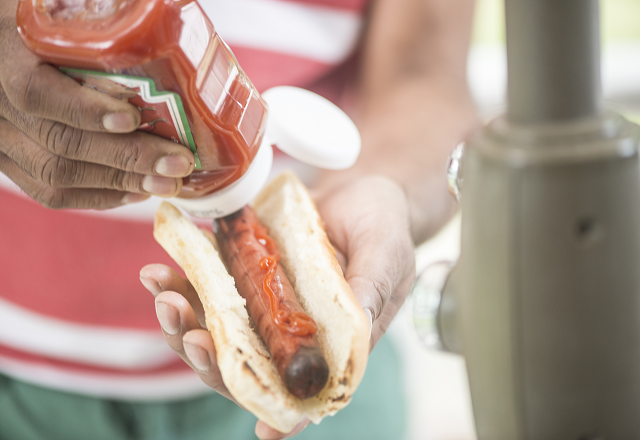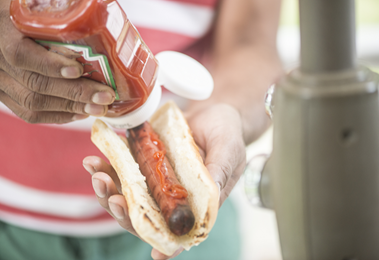Prediabetes Diet
Featured Expert
-
Tara Seymour, M.S., R.D., L.D.N., C.D.C.E.S.

If your doctor says your bloodwork reveals prediabetes, you’re bound to have questions about what’s best to eat. Tara Seymour, an advanced practice clinical dietitian and diabetes educator at Johns Hopkins, provides guidance on how a healthy diet and lifestyle can control — and even help reverse — prediabetes.
Diet for Prediabetes — What foods should I eat?
People with prediabetes have fasting blood sugar levels that are elevated, but not to the point that they meet the criteria of type 2 diabetes.
The key to warding off progression of prediabetes is a balanced approach to diet, says Seymour.
“People with prediabetes do not have to eliminate entire food groups,” she explains. “All foods can fit in the meal plan, and patients should steer clear of fad diets and other strategies that promise quick fixes, since their claims are not supported. We encourage making gradual behavior changes. Small changes can lead to big results.”
With that in mind, she regards the Mediterranean diet as the gold standard for people with prediabetes, with its emphasis on whole grains, lean protein and healthy fats.
She also refers patients to diabetes meal planning recommendations from the Centers for Disease Control and Prevention and a version of the MyPlate guidelines issued by the U.S. Department of Agriculture and adapted by the American Diabetes Association (ADA).
“Though these resources are not specifically for prediabetes, they can serve as a guide to incorporating healthy choices, especially when you’re eating away from home,” Seymour says.
The ADA’s version of the recommendations suggests these proportions for meals:
- 50% of the plate filled with nonstarchy vegetables, such as leafy greens
- 25% with healthy carbohydrates, such as whole grains like brown rice, farro or quinoa
- 25% with lean protein, such as chicken, turkey, fish or tofu, not fried
Water or another zero-calorie beverage is preferred.
Seymour also recommends:
- Avoiding excessive intake of added sugars by limiting sugary beverages, cakes, cookies, candy and snacks
- Limiting portion sizes of refined carbohydrate foods such as white bread, white rice and white pasta
- Incorporating fiber to reach a goal of 25 to 30 grams per day by eating a variety of fruits, vegetables and whole grains
- Limiting saturated and trans fats by choosing lean protein and low-fat dairy
Foods to Avoid If You Have Prediabetes
“Grapefruit and pomegranate juice can interact with some medications, since they are processed by the same liver enzyme that metabolizes medication. That enzyme is cytochrome P450, which accounts for about 75% of the total drug metabolism performed by the body.”
In addition, Seymour advises care with some nutritional supplements. Ginseng, gingko and garlic are OK in moderation, but high doses of these, as you get in over-the-counter supplements, can cause low blood sugar. “When it comes to supplements,” she says, “it is always important to know your risks and follow the proper dietary protocol by consulting your doctor or dietitian.”
“What should I eat for breakfast if I have prediabetes?”
“Opt for balanced meals that incorporate lean protein, low fat dairy and plenty of fiber,” Seymour advises. “Try cereals with at least five grams of fiber per serving, whole fruits, vegetables and whole grains.
“If you’re tempted to skip breakfast, try a low carbohydrate meal replacement bar or shake to start your day off right.”
“What fruits should I avoid with prediabetes?”
Seymour stresses that all types of fruit are OK and unlikely to be a problem for people who have prediabetes (with the exception of pomegranate juice and grapefruit for people taking certain medications).
“Fruit is a carbohydrate that provides both sugar and fiber,” she says. “You will get more fiber eating whole, fresh fruit than you will by drinking fruit juice.”
“All foods can fit,” she adds. “The key is to watch your portion sizes and read labels of prepared items. Fruit juice and canned fruit may have more sugar.”
A professional can help customize a prediabetic meal plan
Because everyone is different and many people with prediabetes have other health issues, Seymour says it is important to tailor prediabetes food plans to the individual. For instance, patients with high cholesterol may do better with a lower-fat approach, while those with high A1C may benefit from a meal plan that’s lower in carbohydrates.
Working with a doctor or dietitian can be helpful. “People diagnosed with prediabetes can ask their primary care practitioner for a referral to a local registered dietitian,” Seymour says. “That way, they can get individual counseling to achieve their health goals.”
Prediabetes and sugar — How much is too much?
Blood sugar levels are important indications of prediabetes, and it’s no secret that most Americans eat more sugar than they should. Sugar can hide in less obvious places, including processed foods such as breakfast cereals, frozen meals, snacks, sauces and dressings.
Though some sugar is necessary for your body to function, too much can worsen prediabetes. Seymour explains: “Carbohydrates are an important source of energy since glucose [blood sugar] is the preferred molecule to fuel the brain. However, excessive intake of refined carbohydrates from added sugar can cause adverse health effects.
Recommendations for Limiting Sugar
“The World Health Organization advises limiting added sugars to less than 10% of your total energy intake. For added health benefits, you would limit sugar calories to 5% or less of your total.
“For example, for someone on a 2,000-calorie daily diet, if they are following the 10% guideline, they would limit sugar calories to about 50 grams, which is about 12 teaspoons. For the 5%, they would stick to 25 grams, or about six teaspoons.
“The American Heart Association is a little more stringent, and for people at risk for heart disease, including those with prediabetes, it recommends less than six teaspoons of sugar a day for women (about 25 grams) and less than nine teaspoons (about 36 grams) a day for men.”
That’s not a lot. Seymour points out that one can of soda contains about 32 grams of sugar, which is about eight teaspoons.
“We urge our patients to watch what they drink,” Seymour says, noting that sweetened beverages such as sodas, sports drinks, juices and gourmet coffee shop creations account for some of the biggest concentrated sources of added sugar. “Just one of these beverages can take up your entire recommended allotment of sugar for the day ― or even several days.”
The 5-20 Rule
Another way to assess whether a product is overly high in sugar is to read the nutrition label. “The general rule for sugar content is choose products with a sugar content of 5% or less of the daily requirement and avoid items in which the amount of sugar is 20% or more of the daily requirement,” Seymour says.
How to Reverse Prediabetes — Lifestyle
Seymour says switching to well-balanced meals high in healthy, fiber-rich foods, along with incorporating more physical activity, can help people with prediabetes take charge of their health.
“It has been well cited in research studies such as the National Institutes of Health’s Diabetes Prevention Program Outcome Study that incorporating healthy eating habits, weight reduction and increased physical activity can lower your risk of developing type 2 diabetes.
“Additionally, lifestyle changes resulting in modest weight loss have shown to delay the onset of type 2 diabetes by 34% for four years compared to placebo, which was an outcome of the Johns Hopkins’ diabetes prevention program.”
Stay active
Physical activity can help prevent diabetes while boosting heart health. Seymour recommends that people with prediabetes try to get at least 150 minutes per week of moderate to vigorous exercise or aim for 10,000 daily steps. Be sure to check with your doctor before starting exercise or leveling up your current physical activity.
Lose some weight
To steer away from type 2 diabetes, Seymour says men and women should try to achieve and maintain a body mass index of 25 or lower. Waist circumference should be under 35 inches for women and under 40 inches for men.
Even small amounts of weight loss can have a benefit. “The ADA states that moderate rate reduction of 5% to 10% of your body weight can significantly lower your A1C level,” says Seymour. “So, for instance, for a person weighing 200 pounds, a weight loss of 10 to 20 pounds could make a difference.”
Get enough sleep
The relationship among sleep, diabetes and weight gain is important to understand. “Sleep deprivation has been shown to increase people’s cravings for sugary foods,” Seymour says. “People with prediabetes should make sure they’re getting seven to eight hours of sleep a night.”
Avoid excessive alcohol and all tobacco
“These are modifiable lifestyle factors that can significantly lower your risk of several chronic diseases, including type 2 diabetes, heart disease, vascular problems and metabolic syndrome,” Seymour explains.
Stay on top of your numbers
Seymour says people with prediabetes should be vigilant about their laboratory test results. “Know your ABCs,” she advises. “That’s A1C, blood pressure and cholesterol. And if you’re at risk or have prediabetes, make sure you follow up with your A1C level with a blood test at least yearly.”
Reversing Prediabetes — Is it possible?
Yes! “If you’ve been diagnosed with prediabetes, progressing to diabetes is not a given,” Seymour emphasizes.
In addition to taking medications, she says there are other ways to take control.
“Adopting a well-balanced diet, staying active, controlling your weight can put you in control, enabling you to arrest or even reverse the process,” she says.
“I like this quote from the CDC: ‘Life doesn’t always give you the time to change the outcome. Prediabetes does.’”









